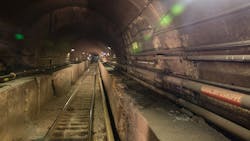Hudson Tunnel Project gets long waited final environmental statement and record of decision
The Federal Railroad Administration (FRA) and Federal Transit Administration (FTA) issued the Final Environmental Impact Statement (EIS) and Record of Decision (ROD) for the Hudson Tunnel Project on May 28, meeting a deadline FRA committed to in April.
“This is a big step for the Northeast, and for the entire country, as these tunnels connect so many people, jobs and businesses. This decision is also an important reminder that we are still capable of working together to advance ambitious projects that can make life better for people, connect communities and deliver a stronger future. Now we need to make sure to provide the funding America needs to deliver world-leading infrastructure in this region and in every part of the country,” said U.S. Secretary of Transportation Pete Buttigieg.
The move clears the way for the project to work toward final design and construction. The Gateway Development Commission (GDC) explained with the ROD in hand, real estate property acquisition, advanced engineering design, utility relocation and other pre-construction activities can move forward.
“Completion of the FEIS and ROD is a huge milestone for the Hudson Tunnel Project that has been years in the making,” said the GDC Commission Co-Chairs Steven M. Cohen, Balpreet Grewal-Virk and Vice Chair Anthony Coscia. “This is a project of true national significance, and we thank our federal partners…for the extraordinary dedication of resources and commitment to completing this process quickly. The Record of Decision opens the door on a new phase of work to advance the new Hudson River Tunnel to full construction, improving reliability for riders and supporting thousands of good paying jobs in the region and across America.”
The Hudson Tunnel Project scope includes two components: The construction of a two-track Hudson River rail tunnel between New Jersey and Manhattan and rehabilitation of the existing North River Tunnel, which sustained significant damage during Superstorm Sandy. The existing North River Tunnel was constructed in 1910 and is the sole passenger rail connection between Manhattan and New Jersey and the Northeast Corridor.
The GDC says the project’s purpose and need is to both maintain the level of service provided by Amtrak and New Jersey Transit through the existing North River Tunnel and improve overall reliability, resiliency and redundancy of the rail conduit between New Jersey and New York.
The Hudson Tunnel Project is a major element of the Gateway Program, which aims to improve rail infrastructure along a 10-mile segment of the Northeast Corridor that sees up to 450 trains per day.
“The completion of the FEIS and issuance of the ROD by the FRA and FTA represents a crucial step forward for the Hudson Tunnel Project, which will directly benefit NJ Transit customers with more reliable and resilient rail service along the busiest rail corridor in the nation,” said NJ Transit President and CEO Kevin S. Corbett. “Combined with NJ Transit’s Portal North Bridge Replacement Project, which continues to advance and remains on track for a construction award by the end of this year, we’re positioning the entire Northeast Corridor to safely and reliably meet the demands of NJ Transit customers for generations to come.”
Amtrak President Stephen Gardner added, “We join our colleagues and partners in celebrating a Record of Decision on the Hudson Tunnel Project – a critical milestone that, now reached, moves this important project ever closer to the start of construction. The Hudson Tunnel Project will improve resiliency and reliability in the heart of the Northeast Corridor, positively impacting the lives of thousands of daily commuters and intercity passengers. Along with the expansion of Penn Station New York, the Portal North Bridge Project and other improvements, the Hudson Tunnel Project is an essential and long overdue first step toward replacing the existing configuration with a fully integrated, modernized four-track railroad.”
About the Author

Mischa Wanek-Libman
Group Editorial Director
Mischa Wanek-Libman is director of communications with Transdev North America. She has more than 20 years of experience working in the transportation industry covering construction projects, engineering challenges, transit and rail operations and best practices.
Wanek-Libman has held top editorial positions at freight rail and public transportation business-to-business publications including as editor-in-chief and editorial director of Mass Transit from 2018-2024. She has been recognized for editorial excellence through her individual work, as well as for collaborative content.
She is an active member of the American Public Transportation Association's Marketing and Communications Committee and served 14 years as a Board Observer on the National Railroad Construction and Maintenance Association (NRC) Board of Directors.
She is a graduate of Drake University in Des Moines, Iowa, where she earned a Bachelor of Arts degree in Journalism and Mass Communication.
